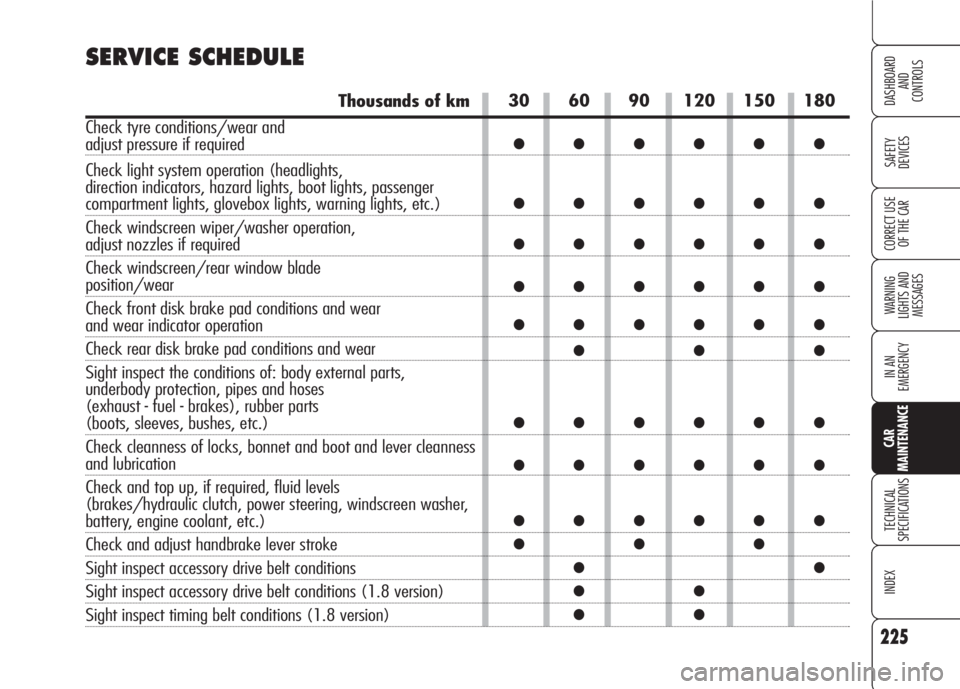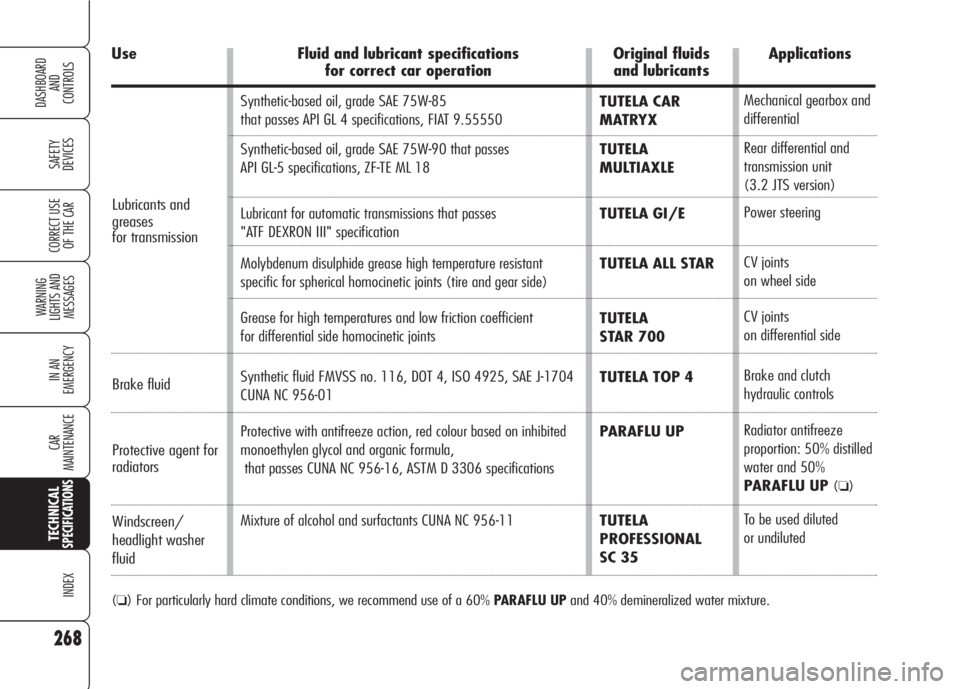clutch Alfa Romeo 159 2008 Owner handbook (in English)
[x] Cancel search | Manufacturer: ALFA ROMEO, Model Year: 2008, Model line: 159, Model: Alfa Romeo 159 2008Pages: 303, PDF Size: 5.18 MB
Page 160 of 303

158
SAFETY
DEVICES
WARNING
LIGHTS AND
MESSAGES
IN AN
EMERGENCY
CAR
MAINTENANCE
TECHNICAL
SPECIFICATIONS
INDEX
DASHBOARD
AND
CONTROLS
CORRECT USE
OF THE CAR
Gear selection
As soon as the conditions of the traffic
and road allow, use a higher gear. Us-
ing a low gear to obtain brilliant perfor-
mance increases consumption. In the
same way improper use of a high gear
increases consumption, emissions an en-
gine wear.
Top speed
Fuel consumption considerably increas-
es with speed. Avoid superfluous brak-
ing and accelerating, which cost in terms
of both fuel and emissions.
Acceleration
Accelerating violently increasing the revs
will greatly affect consumption and emis-
sions: acceleration should be gradual and
should not exceed the maximum torque.CONDITIONS OF USE
Cold starting
Short journeys and frequent cold starts
do not allow the engine to reach opti-
mum operating temperature. This results
in a significant increase in consumption
levels (from +15 to +30% on the urban
cycle) and emission of harmful sub-
stances.
Traffic and road conditions
Rather high consumption levels are tied
to situations with heavy traffic, for ex-
ample in queues with frequent use of
the lower gears or in cities with many
traffic lights. Also winding mountain
roads and rough road surfaces adverse-
ly affect consumption.
Traffic hold-ups
During prolonged hold-ups (e.g.: level
crossings) the engine should be
switched off.
DRIVING STYLE
Starting
Do not warm the engine with the car
at a standstill or at idle or high speed:
under these conditions the engine
warms up much more slowly, increasing
electrical consumption and emissions. It
is therefore advisable to move off im-
mediately, slowly, avoiding high speeds.
This way the engine will warm faster.
Unnecessary actions
Avoid accelerating when waiting at traf-
fic lights or before switching off the en-
gine. This and also double declutching
is absolutely pointless on modern cars
and also increase consumption and pol-
lution.
Page 227 of 303

225
SAFETY
DEVICES
WARNING
LIGHTS AND
MESSAGES
IN AN
EMERGENCY
TECHNICAL
SPECIFICATIONS
INDEX
CORRECT USE
OF THE CAR
DASHBOARD
AND
CONTROLS
CAR
MAINTENANCE
30 60 90 120 150 180
●●●●●●
●●●●●●
●●●●●●
●●●●●●
●●●●●●
●●●
●●●●●●
●●●●●●
●●●●●●
●●●
●●
●●
●●
SERVICE SCHEDULE
Thousands of km
Check tyre conditions/wear and
adjust pressure if required
Check light system operation (headlights,
direction indicators, hazard lights, boot lights, passenger
compartment lights, glovebox lights, warning lights, etc.)
Check windscreen wiper/washer operation,
adjust nozzles if required
Check windscreen/rear window blade
position/wear
Check front disk brake pad conditions and wear
and wear indicator operation
Check rear disk brake pad conditions and wear
Sight inspect the conditions of: body external parts,
underbody protection, pipes and hoses
(exhaust - fuel - brakes), rubber parts
(boots, sleeves, bushes, etc.)
Check cleanness of locks, bonnet and boot and lever cleanness
and lubrication
Check and top up, if required, fluid levels
(brakes/hydraulic clutch, power steering, windscreen washer,
battery, engine coolant, etc.)
Check and adjust handbrake lever stroke
Sight inspect accessory drive belt conditions
Sight inspect accessory drive belt conditions (1.8 version)
Sight inspect timing belt conditions (1.8 version)
Page 257 of 303

255
SAFETY
DEVICES
WARNING
LIGHTS AND
MESSAGES
IN AN
EMERGENCY
CAR
MAINTENANCE
INDEX
CORRECT USE
OF THE CAR
DASHBOARD
AND
CONTROLS
TECHNICALSPECIFICATIONS
FUEL FEED/IGNITION
1.8 1.9 JTS - 2.2 JTS1.9 JTDM8V
3.2 JTS1.9 JTDM16v - 2.4 JTDM
Fuel feed Multipoint fuel injection Direct injection Direct injection, Common Rail
Modifications or repairs to the fuel feed system that are not carried out properly or do not
take the system’s technical specifications into account can cause malfunctions leading to
the risk of fire.
1.9 JTS - 2.2 JTS
1.9 JTD
M8V- 1.9 JTDM16v
2.4 JTDM200 HP
Six forward gears + reverse
and synchronisers for speeds
Dry single disk
with hydraulic control
Front 1.8
Five forward gears + reverse
and synchronisers for speeds
Dry single disk
with hydraulic control
Front
2.4 JTDM210 HP 4x4
3.2 JTS
Six forward gears + reverse
and synchronisers for speeds
Dry single disk
with hydraulic control
Four-wheel drive
TRANSMISSION
Gearbox
Clutch
Drive
IMPORTANTIn the event of difficult disengagement, due to significant difference of grip between front and rear axle, do
not insist with heavy accelerations: it is actually more effective an attempt of disengagement at medium slow engine rpm,
with pauses of a few seconds if several attempts are necessary.
Page 270 of 303

268
SAFETY
DEVICES
WARNING
LIGHTS AND
MESSAGES
IN AN
EMERGENCY
CAR
MAINTENANCE
INDEX
CORRECT USE
OF THE CAR
DASHBOARD
AND
CONTROLS
TECHNICALSPECIFICATIONS
Synthetic-based oil, grade SAE 75W-85
that passes API GL 4 specifications, FIAT 9.55550
Synthetic-based oil, grade SAE 75W-90 that passes
API GL-5 specifications, ZF-TE ML 18
Lubricant for automatic transmissions that passes
"ATF DEXRON III" specification
Molybdenum disulphide grease high temperature resistant
specific for spherical homocinetic joints (tire and gear side)
Grease for high temperatures and low friction coefficient
for differential side homocinetic joints
Synthetic fluid FMVSS no. 116, DOT 4, ISO 4925, SAE J-1704
CUNA NC 956-01
Protective with antifreeze action, red colour based on inhibited
monoethylen glycol and organic formula,
that passes CUNA NC 956-16, ASTM D 3306 specifications
Mixture of alcohol and surfactants CUNA NC 956-11TUTELA CAR
MATRYX
TUTELA
MULTIAXLE
TUTELA GI/E
TUTELA ALL STAR
TUTELA
STAR 700
TUTELA TOP 4
PARAFLU UP
TUTELA
PROFESSIONAL
SC 35Mechanical gearbox and
differential
Rear differential and
transmission unit
(3.2 JTS version)
Power steering
CV joints
on wheel side
CV joints
on differential side
Brake and clutch
hydraulic controls
Radiator antifreeze
proportion: 50% distilled
water and 50%
PARAFLU UP
(❏)
To be used diluted
or undiluted
Use Fluid and lubricant specifications Original fluids Applications
for correct car operation and lubricants
Lubricants and
greases
for transmission
Windscreen/
headlight washer
fluid Protective agent for
radiators Brake fluid
(❏) For particularly hard climate conditions, we recommend use of a 60% PARAFLU UPand 40% demineralized water mixture.